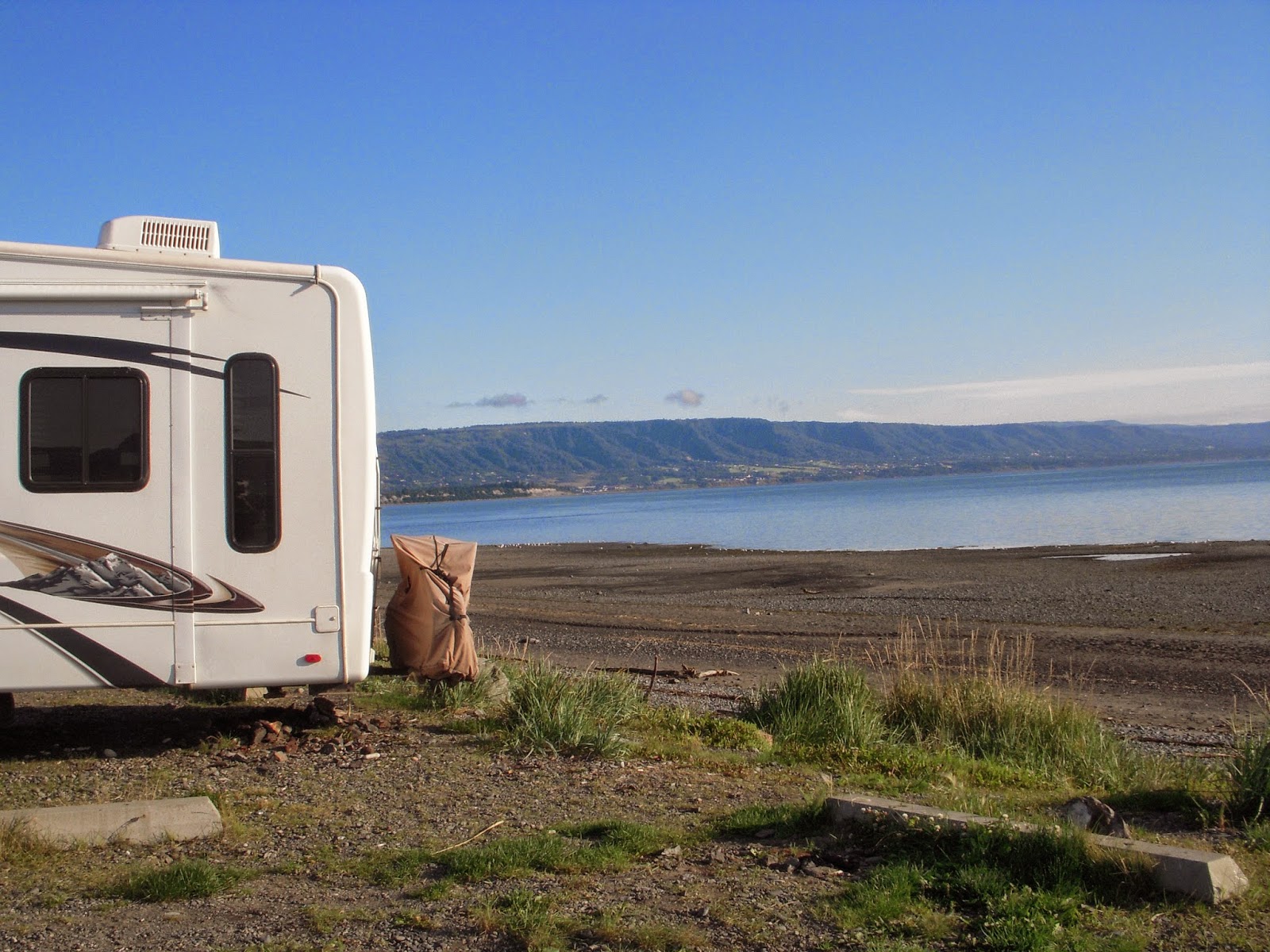Homer Spit!
The Homer Spit is a geographical landmark located in Homer, Alaska on the southern tip of the Kenai Peninsula. The spit is a 4.5-mile (7.2 km) long piece of land jutting out into Kachemak Bay. The spit is also home to the Homer Boat Harbor. The harbor contains both deep and shallow water docks and serves up to 1500 commercial and pleasure boats at its summer peak. Additional features and attractions include The Nick Dudiak Fishing Lagoon, which is an artificial "fishing hole", campgrounds, hotels, and restaurants and the Salty Dawg Saloon, which is constructed out of several historic buildings from Homer. Hundreds of eagles have gathered there in winter to be fed by Jean Keene, the "Eagle Lady". The Spit features the longest road into ocean waters in the entire world, taking up 10–15 minutes to cover by car.
Two different theories postulate that the spit originates either from the tidal swells and currents of Cook Inlet and Kachemak Bay over millennia of sand buildup, or that it was pushed into place by now-retreated glaciers. In 1899, the Cook Inlet Coal Fields Company laid a railroad track along the spit, connecting the docks to the coal fields along Kachemak Bay. The resulting business led to the development of what eventually became Homer, Alaska. In the 1960s, several hippies, known as "spit rats", traveled from all around to camp on the Homer Spit, many of them becoming successful commercial fishermen over time. The 1964 Alaska earthquake shrank it to 508 acres (2.06 km2), and killed most of the vegetation, making it today mostly gravel and sand.
Our Campground provided us with a beautiful view.
We all hated to leave
But
On The Road Again
With Beautiful Views
What's So Special About the Turnagain Arm Bore Tide?
Well, it’s huge—one of the biggest in the world, actually. Also, all other bore waves run up low-lying rivers in more southerly latitudes. The Turnagain Arm bore wave is the only one that occurs in the far north and the only one bordered by mountains, making it the most unique and most geologically dramatic bore tide in the world. It’s also amazingly accessible: you can see it by road along its entire 40- to 50-mile length. And it’s a wildlife-spotting opportunity: harbor seals often ride the tide into Turnagain Arm. Beluga whales may come in a half hour or so later once the water gets deeper.
A tidal bore, often simply given as bore in context, is a tidal phenomenon in which the leading edge of the incoming tide forms a wave (or waves) of water that travels up a river or narrow bay against the direction of the river or bay's current.
Description
Bores occur in relatively few locations worldwide, usually in areas with a large tidal range (typically more than 6 metres (20 ft) between high and low water) and where incoming tides are funneled into a shallow, narrowing river or lake via a broad bay. The funnel-like shape not only increases the tidal range, but it can also decrease the duration of the flood tide, down to a point where the flood appears as a sudden increase in the water level. A tidal bore takes place during the flood tide and never during the ebb tide.
A tidal bore may take on various forms, ranging from a single breaking wavefront with a roller – somewhat like a hydraulic jump– to undular bores, comprising a smooth wavefront followed by a train of secondary waves known as whelps. Large bores can be particularly unsafe for shipping but also present opportunities for river surfing.
Two key features of a tidal bore are the intense turbulence and turbulent mixing generated during the bore propagation, as well as its rumbling noise. The visual observations of tidal bores highlight the turbulent nature of the surging waters. The tidal bore induces a strong turbulent mixing in the estuarine zone, and the effects may be felt along considerable distances. The velocity observations indicate a rapid deceleration of the flow associated with the passage of the bore as well as large velocity fluctuations. A tidal bore creates a powerful roar that combines the sounds caused by the turbulence in the bore front and whelps, entrained air bubbles in the bore roller, sediment erosion beneath the bore front and of the banks, scouring of shoals and bars, and impacts on obstacles. The bore rumble is heard far away because its low frequencies can travel over long distances. The low-frequency sound is a characteristic feature of the advancing roller in which the air bubbles entrapped in the large-scale eddies are acoustically active and play the dominant role in the rumble-sound generation.
And The Beluga Whales Were There!!
Time For a Social!
And The Competition Heats Up!
Ed & Tim
Sonny & The "Don"
Nancy & Mike
More Spectacular Views As We Travel Along!
This Is A Picture Of A Type Of Grass.
Really Pretty!
Around Every Bend
Is
A View!
Messages on the banks of the side of the road
made with rocks!
Ella!
Miss You Guys!
Nice Summer Cabin!
Their Transportation!
Don, Hank & Us - Taking a Short Break!
Mag Pies Are All Over Alaska!
Getting Close To Valdez!
Joan Was Good At Getting Shots Out The Windows!
Ice Bucket Challenge!
The Ice Bucket Challenge, sometimes called the ALS Ice Bucket Challenge, is an activity involving dumping a bucket of ice water on someone's head to promote awareness of the disease amyotrophic lateral sclerosis (ALS) and encourage donations to research. It went viral on social media during July–August 2014. In the US, many people participate for the ALS Association, and in the UK, many people participate for the Motor Neurone Disease Association, although some individuals have opted to donate their money from the Ice Bucket Challenge to other organizations.
The challenge encourages nominated participants to be filmed having a bucket of ice water poured on their heads and then nominating others to do the same. A common stipulation is that nominated participants have 24 hours to comply or forfeit by way of a charitable financial donation.
History
The origins of the idea of dumping cold water on one's head to raise money for charity are unclear and have been attributed to multiple sources. The most commonly accepted origin credits Pete Frates, a Bostonian who was diagnosed with ALS in March 2012. Pat Quinn, a friend of Frates who was diagnosed with ALS in 2013, is also credited with creating the challenge.
From mid-2013 to early 2014, a challenge of unknown origin often called the "Cold Water Challenge" became popular on social media in areas of the Northern United States. The task usually involved the option of either donating money to cancer research or having to jump into cold water.[11] According to the Wall Street Journal, the Ice Bucket Challenge was begun by professional golfers as means to support various pet charities.
One version of the challenge, which took place in Salem, Indiana as early as May 15, 2014, involved dousing participants with cold water and then donating to a charity, for example a local child diagnosed with an inoperable brain tumor. In another version, the Auckland Division of the Cancer Society of New Zealand was the beneficiary. As with similar challenges, it was usually filmed so footage can be shared online.
The National Fallen Firefighters Foundation popularized the "Cold Water Challenge" in early 2014 to raise funds as an unsanctioned spin-off of the polar plunge most widely used by Special Olympics as a fundraiser.
On May 20, 2014, the Washington Township, New Jersey fire department posted a video on YouTube participating in the "Cold Water Challenge" with fire hoses. Participating members of the department were subsequently punished for using fire department equipment without permission.
Shifting focus to ALS
The challenge first received increased media attention in the United States on June 30, 2014, when personalities of the program Morning Drive, which airs weekdays on Golf Channel, televised the social-media phenomenon, and performed a live, on-air Ice Bucket Challenge.
Soon after, the challenge was brought to mainstream audiences when television anchor Matt Lauer did the Ice Bucket Challenge on July 15, 2014 on NBC's The Today Show at Greg Norman's challenge.
On the same day, golfer Chris Kennedy did the challenge, then challenged his cousin Jeanette Senerchia of Pelham, New York, whose husband, Anthony, had had ALS for 11 years. Kennedy's challenge was the first documented instance of the challenge being connected with ALS. At this time, the challenge was not connected directly with ALS. Participants would donate to a charity of their choice.
Pete Frates began posting about the challenge on Twitter soon after. Frates was awarded the Stephen Heywood Patients Today Award in 2012 for his fundraising and advocacy work. Frates' Boston College and sporting connections became an initial focus of the challenge and strengthened its focus on ALS.
The President of the United States, Barack Obama, was challenged by Ethel Kennedy but declined, opting to contribute to the campaign with a donation of $100. Justin Bieber[28] (who was criticized for not properly doing the challenge), LeBron James, and "Weird Al" Yankovic also challenged President Obama after completing the Ice Bucket Challenge. Former President George W. Bush completed the challenge and nominated fellow former President Bill Clinton. The Prime Minister of the United Kingdom, David Cameron, was challenged by both Alex Salmond and Russell Brand, but also declined in favour of a donation.
Bill & Nancy!

And So This Day Ends Too!























































No comments:
Post a Comment